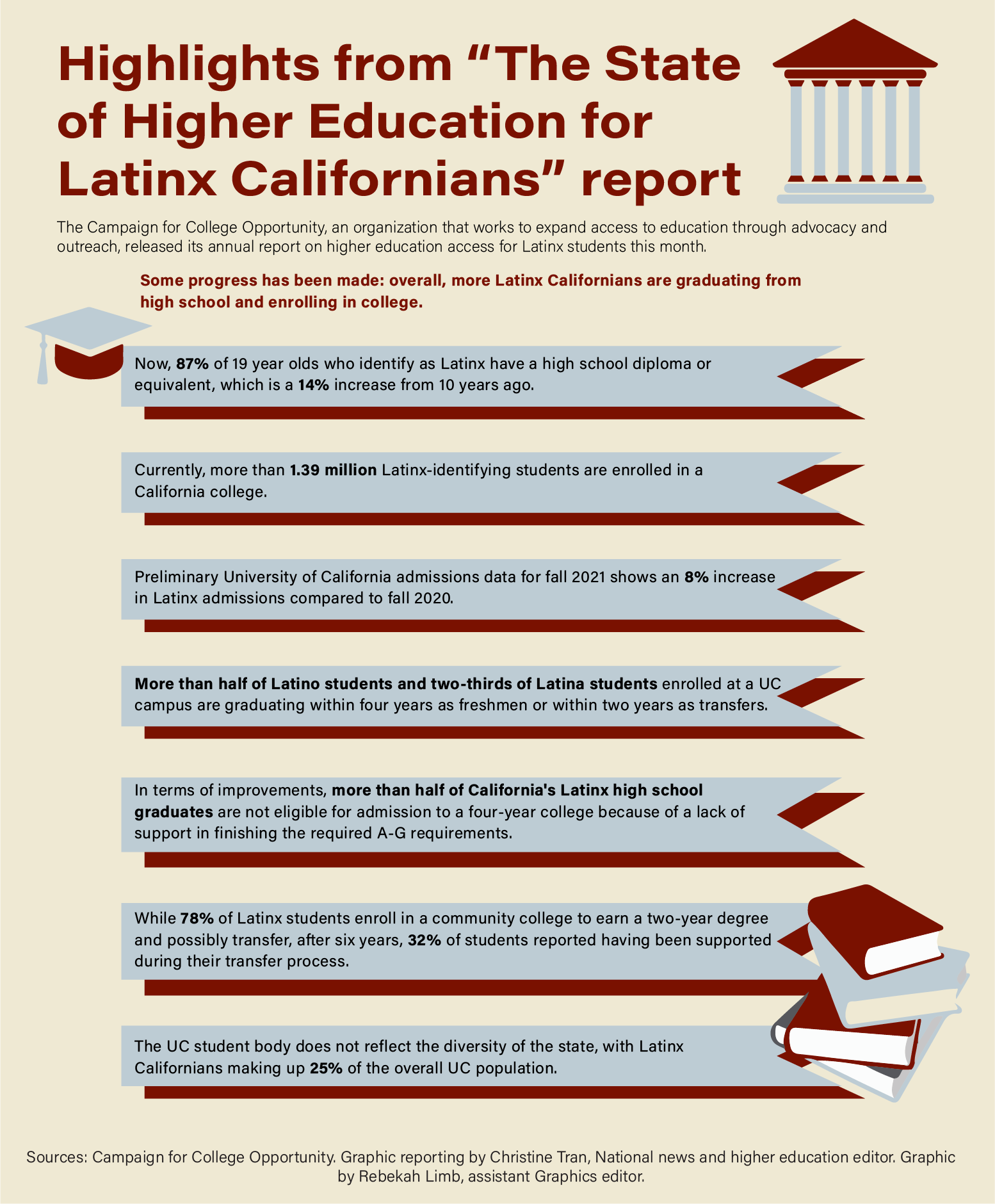Report discusses representation, issues faced by Latinx students in California

By Dylan Tzung
Nov. 28, 2021 11:03 p.m.
Latinx students are graduating high school and enrolling in higher education at historically high rates, but they continue to experience barriers enrolling in and graduating from four-year colleges, according to a recent report about California’s Latinx student population.
The Campaign for College Opportunity, a nonprofit that works to increase educational access to Californians, held a webinar Nov. 9 to unveil its 2021 report “The State of Higher Education for Latinx Californians.” A variety of speakers, including researchers and student leaders involved in supporting Latinx higher education success, discussed some of the key statistics in the report and explored potential steps for moving forward.
Vikash Reddy, the CCO’s senior director of policy research, said the central purpose for this particular report is to tell the story of Latinx students in California and use statistics to explore the evolution of their issues.
The researchers found in the report that the rates of Latinx participation and success in higher education have increased, with 87% of Latinx 19-year-olds graduating from high school in comparison to 73% 10 years ago.
However, researchers also stated that issues with admission eligibility, transfer rates and student support still exist in high schools and California colleges and universities.
At the high school level, only 44% of 2019-2020 Latinx graduates in California met the A-G requirements needed for University of California and California State University admission eligibility, according to the report.
Reddy said making the A-G requirements the default policy for high schools is particularly important because more Latinx students in California who meet the requirements are enrolled in college compared to those who did not complete the requirements.
Additionally, Latinx students are still underrepresented across the UC campuses. According to the report, among all the undergraduates enrolled in the UC system, one in four students is Latinx.
Herman Luis Chavez, the Undergraduate Students Association Council transfer student representative, said the lack of representation is an issue considering how almost half of the state’s population is Latinx identifying.
He said it is particularly important for UCLA to address this issue because it is currently trying to officially become a Hispanic-Serving Institution and be supportive of its Latinx students.
Chancellor Gene Block and Executive Vice Chancellor and Provost Emily Carter announced UCLA’s intent to become an HSI in December 2020. In order to officially be designated as an HSI by 2025, the university’s Hispanic-Serving Institution Task Force must work to support Latinx populations in California high schools and community colleges and improve campus infrastructure for Latinx students.
Chavez added that this support includes hiring Latinx professors and faculty across all academic departments, not only the Chicano and Central American studies department.
“For a student to go through a degree program and not have any Latinx professors, if they identify as Latinx, is an issue,” Chavez said. “It’s an issue of retention and representation and of support, and so I think that that is really critical.”
Gerardo Chavez, the president of the Student Senate of California Community Colleges, also said increasing faculty diversity is particularly important because of the impact faculty has on students.
“It’s really hard to stay motivated when I don’t see individuals, faculty that don’t look like me and come from my experiences,” he said.
The researchers also found evidence to indicate that the transfer pathway system from community college to four-year colleges acts as a barrier to the success of Latinx students in higher education. Latinx students represent 45% of the collective student body across all California Community Colleges. Even though 78% of California Latinx students enroll in a community college with the intention to transfer or earn an associate’s degree, only 32% transfer after six years, according to the report.
Gerardo Chavez, who is also a history student at Riverside City College, said he was struck by the report’s data on transferring because of how closely it mirrors his own experience. He said he was often given conflicting information while speaking to counselors about which courses he needed to take.
This misinformation creates a widespread pattern of students accruing unnecessary units, he said.
The biggest issue he noticed in the transfer pathway, Gerardo Chavez added, is miscommunication between the UC, CSU and CCC, which causes issues with fulfilling transfer requirements.
“I think that the more you are in community college, and maybe this is not the reality for others, but you just become more distant from that goal (of transferring),” he said.
Beyond discussing barriers and successes Latinx students experience, the researchers also provide a list of policy recommendations to solve issues at the high school, college, state and federal levels.
Some of the recommendations highlighted in the report include establishing the A-G coursework as the default curriculum for California high school students, strengthening the CSU Graduation Initiative, increasing the number of Latinx faculty in California’s four-year public institutions, and making financial aid more accessible for Latinx students.
While schools such as Riverside City College have a Latino student engagement center, Gerardo Chavez said, only so many students can be served in a school with thousands of first-generation and low-income students.
Additionally, Herman Luis Chavez said the UC should identify high schools with large Latinx populations and ensure that those schools have counselors who are actively making sure their students are eligible to apply to the UC and the CSU.
Looking forward, he said he hopes the UC will take the report into consideration and the UCLA community will recognize there is always more to be done in terms of better understanding and supporting the Latinx community.
“California’s past, present and future are really predicated on the Latinx population,” Herman Luis Chavez said. “I don’t think you have a past, present or future of California without the Latinx individuals who make up and live and learn in this state.”


